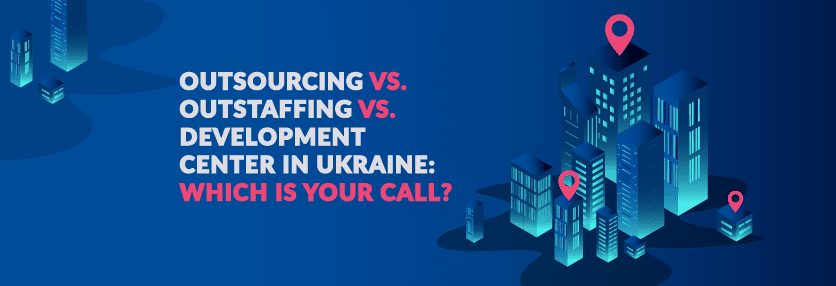Outsourcing vs. Outstaffing vs. Development Center in Ukraine: Which Is Your Call?
If you are a company executive looking for ways to extend your business’ tech capacities, chances are you’ve considered outsourcing, outstaffing or opening a development center abroad. Each of the three approaches has their pros and cons. For example, outsourcing lets you manage the people you’ve contracted from a vendor. Or is it outstaffing? Then how is a development center different? Don’t worry, pwrteams will help you understand the differences and advantages of each of these methods.
Outsourcing vs. Outstaffing vs. Development Centers
Once you’ve decided not to hire an in-house team for your company’s software development, there are three popular approaches you can take: outsourcing, outstaffing and setting up a development center.
In IT outsourcing, you contract a professional third-party outsourcing vendor who has a talent pool of professionals in various technologies and different seniority levels. Once the vendor has your staff requirements, they pick out the necessary professionals for your project. This means that while the people work on your project, they still work for the vendor. IT outsourcing is a good fit when you need to hire an entire software development team including project managers and business analysts.
IT outstaffing looks very similar to outsourcing at first: you contract a third-party vendor who has a pool of IT professionals. De-jure, the outstaffer is their employer but de-facto, these professional are now a part of your team. Think of an outstaffing vendor as the party that takes care of the office and the taxes while you have most of the control over the IT professionals who work for you. Outstaffing is great if you only need software developers and testers since your in-house employees usually do all the management. However, you can still hire PMs or BAs from the outstaffing vendor.
Development centers are a whole other type of employment that has nothing to do with a third-party vendor. Think of it as an office that belongs to your company and people that work for you directly but in another country. A development center is basically your office but in a land far away. You do have lots of control over it, but that control comes with a lot of additional office-related responsibilities and overhead expenses.
So, what should you choose: outsourcing, outstaffing or a development center? Let’s dig deeper into their pros and cons to find out.
Outsourcing: Pros and Cons

According to various estimates, there are up to 4,000 IT companies in Ukraine, and outsourcing makes up the majority of Ukraine’s IT market. Its major IT outsourcing hubs include Kyiv (44,9% of companies), Kharkiv (18,7%), Lviv (9,3%), Dnipro (8,2%) and Odesa (5,5%). Why is outsourcing so popular?
Better execution of particular tasks
Let’s start with the obvious: outsourcing provides quality services at a lower cost. But what’s more important, it can improve your company’s innovative capabilities through interaction and partnerships with world-class suppliers that have tremendous intellectual potential and rich experience. Specialized outsourcing vendors could be better at taking on specific tech tasks than your company since they can boast a talent pool of highly skilled employees.
Flexibility
If the market situation suddenly changes, outsourcing allows you to be more flexible. It’s easier and cheaper to find new suppliers with the necessary capabilities than to restructure the internal activities of your company. Outsourcing lets you focus on your business’ critical operations, making sure they stay under control.
Great option for short-time work
If you only need to add a couple of features, quickly launch a new website or support a product for one season only, outsourcing is the way to go. Since every decent outsourcing vendor has an internal pool of professionals, they can put together a team in no time. And once all the work is done and the contract has ended, there are no hard feelings on either side.
A little bit dangerous
Large organizations can feel threatened since transferring specific functions to outsourcing companies can become a security hazard. Your confidentiality is at risk once you share any sensitive information with a third party. And where there’s a breach in security, there’s a breach in competitiveness and customer loyalty.
Not on your behalf
It’s also worth mentioning that you’re not the one who chooses the people that will work on your project. It’s the outsourcer who does all the picking, and while they claim the developer is a Senior, the person may turn out to be a fresh Junior instead.
Outstaffing: Pros and Cons

Outsourcing and outstaffing are so similar that most people can’t differentiate them. Especially when the same vendor offers both approaches. That’s because they share a lot of the same benefits like cost-effectiveness and flexibility. The critical difference is the level of control (and responsibility) you get over your team. Let’s have a look at the pros and cons of outstaffing.
Saves you time and costs
Since the outstaffing vendor is the one who technically hires people, you don’t have to bother about any overhead connected with that. The worker’s taxes, social benefits, vacations, sick leaves even computers are none of your problems. This way, the vendor saves you time and frustration. Plus, you get to infiltrate a foreign country market without having to set up an office there.
You get control
The employees who work on your project from the outstaffer’s office report to you directly. That’s the most control you can get without having to bother about your employees’ working conditions. Your extended team is also more likely to believe in your company’s mission than an outsourcing team. And if they share your mission, they’ll strive to help you reach your goal and won’t need someone constantly watching over their shoulder to build high-quality software.
But you have to put a lot of effort into making them feel like an indispensable part of your company. Otherwise, the extended team can get demotivated if they don’t feel that you care about their contribution. Make sure to visit once in a while, try to attend their celebrations and not change the team members or managers too often.
No talent pool
Outstaffers offer all kinds of IT professionals for your project. But they don’t usually have a pool to pick them from; often, these professionals are hired on demand. The upside is you get to personally take part in selecting the people who are right for your project. On the downside, that’s why outstaffing doesn’t go well with short-term projects: with all the time it took to hand-pick the candidates, you wouldn’t want to let them go after just six months. Also, the personal approach can extend the time it takes to gather a team.
Development Centers: Pros and Cons

Increasingly more companies are looking to set up a development center abroad, preferably in a more tech-savvy, less expensive country. Like Ukraine. Most of the companies that set up development centers here are from Europe, North America and Australia. They include world-renowned giants like Samsung, Wargaming, ABBYY, Magento, Yandex, Siemens and others. Why open a development office in Ukraine?
Qualified tech professionals
Because a development center is practically your office, but in another country, you get to select the employees you need – only the best ones. And by 2020, Ukraine will be home to about 200,000 talented IT professionals. Currently, the country has more people working in the tech industry than any other European country. According to DOU, most of them are software developers, QA engineers, project managers, designers, and business analysts.
Designers and business analysts usually have 3 years of experience, Scrum Masters and senior QAs – about 5 years, senior software developers have 7 years, tech leads – 9 years and system architects have over 10 years of experience in the industry. JavaScript, Java, and C# remain the top three languages Ukrainian software developers use.
With great control comes great responsibility
Forgive us this allusion to “Spiderman,” but it’s perfect for illustrating the struggles of a development center. Yes, even in another country, your employees will be loyal and willing to go the extra mile to help your business succeed. Because there is no “vendor” layer between you, development center employees will feel more responsible for the results. But all this depends on your managing skills, how often you visit and if you can make them actually feel like an integral part of your team.
Overhead expenses
Since the development center is yours, the overhead costs are yours too. Someone will have to take care of the infrastructure, the computers, the taxes, the office, the vacations and even coffee. So, add the salary of an office manager and an accountant to your overall expenses.
Let’s sum it up
Outsourcing gives you access to a pool of talents, allows your business to be more flexible in software development and works for short-term projects. Outstaffing saves you time and cost, helps you select the team and handles all the overhead expenses. Development centers are great if you want to hand-pick your employees and control them as long as you invest in making the workers genuinely feel like a part of your team.
Sure, there are both success and failure stories connected with all three of the approaches. But you’re sure to find the one that fits your business best once you carefully consider all the pros and cons.

